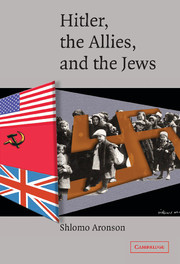Book contents
- Frontmatter
- Contents
- Preface
- Acknowledgments
- List of Abbreviations
- PART I THE MAKING OF THE MULTIPLE TRAP
- PART II THE RESCUE DEBATE, THE MACRO PICTURE, AND THE INTELLIGENCE SERVICES
- 10 Missed Opportunities?
- 11 The Intelligence Services and Rescue Options
- 12 The Jewish “Refugee Traffic”: The Road to Biltmore and Its Ramifications
- 13 American Wartime Realities, 1942–1943
- 14 Bermuda, Breckinridge Long, G-2, Biddle, Taylor and Rayburn, and Palestine Again
- 15 Roosevelt, Stimson, and the Palestine Question: British Inputs
- 16 The Views of Harold Glidden and/or British Intelligence, Consul General Pinkerton, and Rabbi Nelson Glueck
- 17 Various Methods of Rescue
- PART III THE SELF-DEFEATING MECHANISM OF THE RESCUE EFFORTS
- PART IV THE BRAND–GROSZ MISSIONS WITHIN THE LARGER PICTURE OF THE WAR AND THEIR RAMIFICATIONS
- PART V THE END OF THE FINAL SOLUTION: BACK TO HOSTAGE-TAKING TACTICS
- Epilogue: Self-Traps: The OSS and Kasztner at Nuremberg
- Notes on Sources
- Selected Bibliography
- Index
15 - Roosevelt, Stimson, and the Palestine Question: British Inputs
Published online by Cambridge University Press: 22 July 2009
- Frontmatter
- Contents
- Preface
- Acknowledgments
- List of Abbreviations
- PART I THE MAKING OF THE MULTIPLE TRAP
- PART II THE RESCUE DEBATE, THE MACRO PICTURE, AND THE INTELLIGENCE SERVICES
- 10 Missed Opportunities?
- 11 The Intelligence Services and Rescue Options
- 12 The Jewish “Refugee Traffic”: The Road to Biltmore and Its Ramifications
- 13 American Wartime Realities, 1942–1943
- 14 Bermuda, Breckinridge Long, G-2, Biddle, Taylor and Rayburn, and Palestine Again
- 15 Roosevelt, Stimson, and the Palestine Question: British Inputs
- 16 The Views of Harold Glidden and/or British Intelligence, Consul General Pinkerton, and Rabbi Nelson Glueck
- 17 Various Methods of Rescue
- PART III THE SELF-DEFEATING MECHANISM OF THE RESCUE EFFORTS
- PART IV THE BRAND–GROSZ MISSIONS WITHIN THE LARGER PICTURE OF THE WAR AND THEIR RAMIFICATIONS
- PART V THE END OF THE FINAL SOLUTION: BACK TO HOSTAGE-TAKING TACTICS
- Epilogue: Self-Traps: The OSS and Kasztner at Nuremberg
- Notes on Sources
- Selected Bibliography
- Index
Summary
Roosevelt's decisions with regard to Palestine seem easy to follow because he appears to have adopted a shallow, traditional, Wilsonian, pro-Zionist approach at first. During the last two years of World War II, he adopted a rather reserved, if not negative, view of the Zionist endeavor, but on the face of it he promised everyone almost everything in this regard. This strategy was very much influenced by the delicate military and political situation in the Middle East, in Europe, and in other parts of the world that were Muslim to a considerable extent. Roosevelt was also influenced by opinions such as the expertise of a Lieutenant Colonel Harold B. Hoskins, the OSS-affiliated State Department adviser, and by reports (some already mentioned) made by Colonel William J. Donovan, the future director of OSS, who toured the Middle East early in 1941 and gained the impression that the Palestine “Jews wanted to push the Arabs back to the desert from which they had come,” an idea that FDR himself seemed to have endorsed for a while in favor of the Jews. The idea itself originated in a 1937 report on Palestine by the British Royal Commission, headed by Lord Peel, which had recommended the removal of Arabs – by force if necessary – from the territory of the Jewish state in a partitioned Palestine.
- Type
- Chapter
- Information
- Hitler, the Allies, and the Jews , pp. 140 - 146Publisher: Cambridge University PressPrint publication year: 2004



